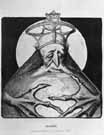
|
|
|

|

|

|

|
|
Click on an image to see a larger, more detailed picture.
|
|
|
|
|
| PROLOGUE: Roots of the Holocaust |

|
pg. 31 |

|
|
|
|
| |
 These Jews, awaiting customers on Berlin's Grenadierstrasse, struggled to make a living on the black market during the lean interwar years.
These Jews, awaiting customers on Berlin's Grenadierstrasse, struggled to make a living on the black market during the lean interwar years.
Photo: Ullstein Bilderdienst
|
 Antisemites fixated on Europe's Jewish Rothschild family, decrying them as political and financial manipulators.
Antisemites fixated on Europe's Jewish Rothschild family, decrying them as political and financial manipulators.
Photo: Ullstein Bilderdienst
|
|
Jews had lived in Vienna since the middle of the 12th century. In 1623, however, the inner city became off-limits to them. Ghettoized for a time, they were completely expelled from Vienna in 1670 by Emperor Leopold I, who subsequently invited them back when economic interests led him to do so. Though they were more or less oppressed for centuries, the prospects for the Viennese Jews improved in 1867 when emancipating changes in the Austro-Hungarian law--the changes were late-arriving in comparison with most European states--gave them full civil rights. These freedoms meant that Jews could own property in Vienna, enter government service, and enjoy greater access to universities--freedoms that brought the city a wave of Jewish immigration. In 1860, for example, Vienna's Jewish population numbered 6200. By 1910 that number had grown to 175,300 (8.7 percent of Vienna's total population). Educational opportunities were especially attractive to Vienna's growing Jewish population. By the turn of the century, nearly one-third of Viennese university students were Jews. In 1913 the percentages of Jews studying medicine and law were 40 and 25, respectively. In business, too, and in the artistic fields, Jews had also achieved considerable success. Far from being celebrated throughout Vienna, however, the gains made by Jews--especially when those gains created unwanted competition--produced resentment among non-Jews who felt that they were being hurt by Jewish success. Vienna's antisemitic currents, moreover, had been intensifying not only in reaction to Jewish success stories but also from fear that impoverished Jews from Eastern Europe and Russia, fleeing for their lives from pogroms directed against them, would flood Vienna with an even more alien Jewish presence, which was embodied in the traditional dress that characterized those predominantly Orthodox Jews. By the time Hitler took up residence in Vienna in 1907, antisemitism ran high. Much of it was based on a two-part principle: (1) all Jews, no matter their differences, were essentially--ethnically or even racially--the same; (2) all Jews were different, dangerously so, from Vienna's non-Jewish population, no matter how much or how little they seemed to be part of it. Newspapers and political tracts were full of antisemitic commentary. Local politics was charged with antisemitic rhetoric. Antisemitism, in short, filled the Viennese air that Hitler breathed.
|
|

|

|

|

|
 1896: Anti-Jewish violence accompanying the Dreyfus Affair inspires eyewitness reporter and Hungarian Zionist Theodor Herzl to publish Der Judenstaat (The Jewish State), a work that promotes Zionism; See 1897.
1896: Anti-Jewish violence accompanying the Dreyfus Affair inspires eyewitness reporter and Hungarian Zionist Theodor Herzl to publish Der Judenstaat (The Jewish State), a work that promotes Zionism; See 1897.
|
 1897: The World Zionist Organization (WZO) is created at Basel, Switzerland. Zionist leader Theodor Herzl, who has covered antisemitic violence as a journalist, calls for a Jewish state.
1897: The World Zionist Organization (WZO) is created at Basel, Switzerland. Zionist leader Theodor Herzl, who has covered antisemitic violence as a journalist, calls for a Jewish state.
|
 1897: Antisemitic politician Dr. Karl Lueger is elected mayor of Vienna, running on the electoral ticket of the antisemitic Christian Social Party.
1897: Antisemitic politician Dr. Karl Lueger is elected mayor of Vienna, running on the electoral ticket of the antisemitic Christian Social Party.
|
 1899: Die Grundlagen des 19. Jahrhunderts (Foundations of the Nineteenth Century), an antisemitic book by Houston Stewart Chamberlain, is published in Germany. It holds that human history is a battle between Jews and Aryans.
1899: Die Grundlagen des 19. Jahrhunderts (Foundations of the Nineteenth Century), an antisemitic book by Houston Stewart Chamberlain, is published in Germany. It holds that human history is a battle between Jews and Aryans.
|
 1899: Action Française (French Action), an antisemitic group, is founded in France.
1899: Action Française (French Action), an antisemitic group, is founded in France.
|
|
|
|
|
| PROLOGUE: Roots of the Holocaust |

|
pg. 31 |

|
|
The Holocaust Chronicle
© 2009 Publications International, Ltd.
|
|
